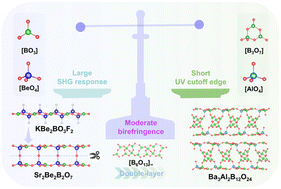Nonlinear optical (NLO) crystals capable of expanding the spectral region of solid-state are of great importance for many high-tech applications, yet their rational structure design remains a great challenge because of the conflicting property requirements among second harmonic generation (SHG) response, ultraviolet (UV) cut-off edge, and birefringence. Herein, based on the chemical disubstitution of the classic NLO crystal Sr2Be2B2O7 (SBBO), i.e., substituting [BO3] triangles with larger π-conjugated [B3O7] groups and substituting high-toxic [BeO4] tetrahedra with environment-friendly [AlO4] tetrahedra, a new high-performance aluminoborate NLO crystal, Ba3Al2B12O24, has been successfully designed and synthesized. The theoretical calculations and optical property measurements indicate that Ba3Al2B12O24 exhibits not only the largest SHG response among the reported aluminoborates (2.7 × KH2PO4), but also a short UV absorption edge (<190 nm) and moderate birefringence. More importantly, Ba3Al2B12O24 melts congruently, and a single crystal with a size of 9 × 5 × 2 mm3 has been grown by the top-seeded-solution-growth method. These demonstrate that Ba3Al2B12O24 is a promising NLO crystal and the chemical disubstitution is a feasible strategy for the exploration of functional materials.
![Graphical abstract: Ba3Al2B12O24: a beryllium-free member of the Sr2Be2B2O7 family with a 2∞[B12Al2O28] double-layered structure](http://pubs.rsc.org/en/Image/Get?imageInfo.ImageType=GA&imageInfo.ImageIdentifier.ManuscriptID=D5SC03854E&imageInfo.ImageIdentifier.Year=2025)

